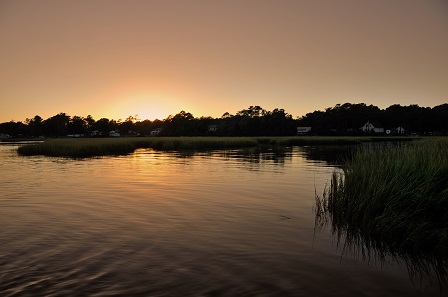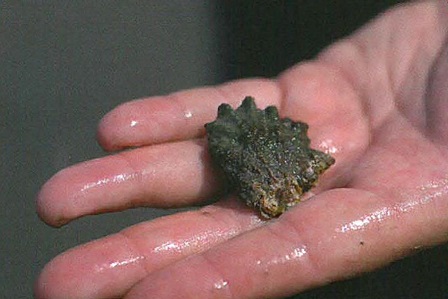Waterfront Access: Meetings Highlight Spectrum of Needs

In coastal North Carolina, access issues cover the waterfront.
People seeking access — for commercial and recreational fishing, seafood handling, paddling, boating, operating marine-related businesses or simply wading in sound and river waters — shared their recent public comment sessions held along the coast.
I think you’ve hit a nerve — and you now have more stakeholders than a good night at Outback,” said Willy Phillips of Columbia, the first speaker at the Manteo session Jan. 30.
“I know when we were growing up it was always fishing or surfing or whatever — ‘You should have been here yesterday.’ And I really don’t want to have to continue saying that to the people that come behind us.”
Bob Simpson of Carteret County noted that people wish to visit the coast because of the waters. Thus, state and local government agencies should consider the long-term economics of the coast, he added. “We can no longer afford to cater to short-term thinking.”
Convened by the N.C. Waterfront Access Study Committee, the meetings in Manteo, Morehead City and Wilmington together drew more than 275 people. Dozens more shared thoughts through written comments and e-mail.
The 21-member committee, with representatives from state and local government agencies and a variety of stakeholder groups, is preparing a report that will be presented to the N.C. Joint Legislative Commission on Seafood and Aquaculture in April.
By law, the committee “shall study the degree of loss and potential loss of the diversity of uses… and how these losses impact access to the public trust waters of the state.”
Since September, the committee has reviewed potential recommendations, including but not limited to:
- using and expanding existing trust funds to purchase waterfront parcels;
- expanding the “present use value” tax option now available for agricultural and forestry operations;
- encouraging the use of conditional zoning and other special district options within local land-use plans; and
- funding a socioeconomic impact study of sustaining and expanding working waterfronts and public access.
“The committee appreciates the speakers’ great passion and conviction on the topic of preserving and enhancing working waterfronts and public access uses along the state’s shore,” said Michael Voiland, executive director of North Carolina Sea Grant and chair of the committee.
“The public statements not only validated most of our thinking to date, but also alerted us to a few aspects that had not been raised in the committee meetings.”
ANGLERS, BOATERS, PADDLERS
For generations, families from across the state have headed to the coast for a day or weekend to fish from oceanfront piers or launch boats onto sound waters and brackish creeks.
Thanks to better highways, getting to the coast is easier than ever. But upon arrival, daytrippers say fewer piers and long lines at public boat launching sites are the rule.
Ken Humphrey of Morehead City described meeting a Winston-Salem man who was near tears. The man had promised his grandsons a day of fishing — but by 1 p.m. he could not find an open launch ramp.
The state has good oceanfront access, but “when you get to the roads less traveled in North Carolina, there becomes a dearth of such access points,” said Jack Spruill of Hampstead. He encouraged the committee to include “low-key personal and family use” of public waters, such as fishing from shore, putting in a skiff or letting the kids splash around.
Angler Oscar Palmer of Leland looks for public launch sites, which can be up to 30 miles or more apart. “Wetslips and drystacks are getting prohibitive for the average working guy like myself,” he said.
Many privately owned launch spots that had been low-cost options for generations are being sold, said Bob Bryant. He cited the recent closing of the Sneads Ferry Campground and Marina that had more than 70 parking slots.
Paddlers also are concerned about the loss of traditional “put-in” sites included in maps published by the Crystal Coast Canoe and Kayak Club. “People-powered watercraft do not require expensive infrastructure, only a grassy or sandy path to the water and a sand beach,” said Laura Bader, club representative. “We hope our voices will be heard for future construction projects, such as the Cape Carteret/Emerald Isle bridge access point.”
Several speakers suggested that access could be provided by the N.C. Department of Transportation at bridge spans and landings, and related easements.
While many comments focused on estuarine waters, several speakers noted the closing of oceanfront fishing piers after parcels change hands.
Outer Banks Fishing Pier owner Garry Oliver said that operations like his are part of many families’ histories and coastal lore. Countless youngsters caught their first fish on his pier. “Where else can you get a day of entertainment for less than $10?”
Some pier owners suggest that the state should not buy piers, arguing that it would be unfair competition with existing businesses.
But if the General Assembly decides to fund an effort to purchase piers and provide operational funds, the North Carolina Aquariums — with locations at Roanoke Island, Pine Knoll Shores and Fort Fisher — would welcome the opportunity to operate a variety of programs at the sites.
Donna Moffitt, director of the Fort Fisher aquarium, said the aquariums could provide traditional ocean pier fishing and beach access, as well as educational exhibits and programs, environmental monitoring. and other research efforts.
WORKING WATERFRONTS
“North Carolina needs to remember its past to move forward effectively,” said David Hilton, a commercial fisherman from Ocracoke. “We are creeping toward an economy totally based on tourism.”
Others agreed. “Every week or two weeks you notice another recreational yacht in the place of a work boat,” said Karen Amspacher of the Core Sound Waterfowl Museum on Markers Island. Waterfronts and fish houses have as much historical value as colonial mansions, she added.
Jim Waterfield, a fish house owner in Knotts Island, spoke of increasing tension between long-time residents and newcomers who describe stacks of crabpots as “unsightly.”
And Jeff Aiken of Hatteras Island has fielded complaints that his ice-making machines are too noisy. He fears fish houses like his are fast becoming museums, as younger generations increasingly choose jobs off the water.
“I don’t mind working in a museum every day if it’s a working museum,” Aiken said. “But if I’ve got to put wax fishermen in it, I’m not interested.”
Similar sentiments were echoed along the coast. “Fishermen are being pushed out of their habitat,” said William Hickman of Brunswick County. He also cited a loss of commercial fishing slips at the Southport Marina, which is owned by the N.C. State Ports Authority.
While state officials are offering incentives for new companies to come to North Carolina, they are forgetting about industries that have been in the state for centuries, said Gerry Smith, a fish house and boatyard owner on the Beaufort-Morehead City causeway.
Smith does not want a subsidy. “All I want is to be able for my family to keep on doing what we have been doing.”
Melvin Shepherd said that while state and regional committees were looking at fish stocks and habitat issues, coastal water access was slipping away. “Sneads Ferry right now is right at the edge of losing all its boats’ ability to dock — large and small.”
Betty Norman Edens of Sneads Ferry agreed. “I am one of those people crying for your help,” she told the committee. “Don’t let North Carolina become Florida.”
BUSINESS INTERESTS
Some business owners said that they do not want additional layers of government — and reminded the committee that access solutions must serve the entire state.
“There’s no free ride,” said Duke Geraghty of the Outer Banks Home Builders Association. “It’s got to be done with broad-based taxes.”
The N.C. Home Builders Association (NCHBA) supports the acquisition and maintenance of waterfront access, Lisa Martin told the committee. But, she added in written comments, “not all waterfront property needs to be completely accessible to the public. Private property rights must be respected.”
NCHBA questioned zoning approaches to advance access and also “opposes any new tax or fee on the development or transfer of property for the purpose of supporting a coastal access working waterfront trust fund.”
Melanie Cook of the Business Alliance for a Sound Economy repeated the NCHBA concern that “present use value” designations for property taxes may shift the tax burden to others.
Cook also suggested that greater study is needed to determine the expected economic impact of potential recommendations by the committee.
Her group, which includes homebuilders, landowners and realtors along the state’s southeastern coast, also would like a list of the areas and types of industry that may be considered for protection so that the “fixes” are adapted to meet specific community and industry needs.
“It would do little to further the fishing industry in the state if a building that once housed a commercial fishing operation is retained, yet there are no fishermen who can live and/or work in the immediate area as a result of unbridled regulation of the industry in the state,” Cook said.
Haywood Newkirk, a real estate appraiser, suggested that many developers would like incentives to include public boat ramps or public marinas, but “these people don’t know who to turn to.”
Some marina owners, like Tim Ward, are trying to develop new access options, but are frustrated by regulations. “We need more boat slips. We need some more access points,” Ward said.
Jim Flynt, owner of Core Creek Marine, voiced similar concerns in dealing with regulators while facing increasing customer demand. “Our phone rings almost daily with boaters seeking to haul-out — a haul-out commitment for hurricanes,” he said.
Jim Hardin of Grady-White Boats, Inc., noted that boating registrations in North Carolina had jumped 69 percent in the past 20 years, and that boat manufacturing and related businesses have annual sales of $1 billion.
He suggested that the state explore revenue sources, such as requiring registrations for nonmotorized watercraft, reallocating gas taxes and increasing efforts in federal grant competitions.
“Boating is big business in North Carolina, and we need sufficient facilities to support our state’s boaters and their rights to enjoy using the public trust waters,” Hardin added in written comments.
State tourism efforts could be an option to fund access projects, several speakers suggested. And coastal tourism marketing campaigns could note the value of fresh local seafood.
“Any time I eat seafood, I ask where it came from,” said Carol Mclntyre of Sneads Ferry.
Alton Ballance of Ocracoke said there are no simple solutions. But, he added, continued efforts will benefit year-round communities and tourists alike. “Create a North Carolina coast that has great diversity, and they’ll come back.”
Small communities in particular need help, several speakers explained.
“There are a mind-boggling number of different agencies that seem to blend all together. A single clearinghouse that could lead small communities in the right direction would be a major help. We have very dedicated volunteers, but dealing with state bureaucracy is most often a very daunting and discouraging process for the novice,” said Don Saddlemire of Sneads Ferry.
Although unincorporated, Wanchese may be ahead of many communities looking at zoning options to preserve traditional waterfront uses.
“Wanchese did something extraordinary for a small, local fishing village,” Tina Beacham explained. “Our zoning plan was designed in consideration of the different aspects of the community. Some areas in Wanchese are residential, some are commercial, and some are strictly water related. We designed each area to reflect what that area has historically been and how we wanted to see it for the future.”
Wilmington, the largest city along the North Carolina coast, faces similar challenges on a different scale, hi particular, the city is concerned that many traditionally public access points have now become exclusive, senior planner Philip Prete said.
Thus, city officials suggest state funds are needed to purchase critic parcels. Wilmington City Council passed a resolution to encourage the state to identify ways to ensure public access to coastal waters “to maintain the cultural integrity and character of coastal North Carolina for the benefit and enjoyment of all the people of the state.”
Doug Harris, chairman of the Carteret County Commissioners, told the committee that public comments focused on preserving and maintaining, rather than creating new waterfronts. “I wonder if that’s not because the people who organized you, and sent you here, realize that the volume and complexity and maze of regulations that one would have to go through to create any new working waterfronts are almost impossible.”
In recent years, Carteret County and its municipalities have found funding for access projects through the N.C. Division of Coastal Management and the Clean Water Management Trust Fund.
But, Morehead City Manager Randy Martin said, the needs are great — and existing sources are limited. “A small municipality like Morehead City, with less than 10,000 permanent residents, cannot take on the responsibility to provide water access for the entire state of North Carolina,” he said.
The N.C. Coastal Federation, which highlighted access issues in its 2006 State of the Coast report, had speakers at each of the regional comment sessions. They highlighted a variety of issues, including a need for more shellfish recycling sites, recent sales of access points by government agencies to private developers, and a request that aquaculture operations be included in the list of traditional waterfront uses.
Coastkeeper Jan DeBlieu said the large crowds at the meetings reflect public concern. “I think this is a vital effort. We’re all hoping that this is not just going to be a study that ends up on a shelf.”
For updates on the N.C. Waterfront Access Study Committee, go online to http://ncseagrant.ncsu.edu/news-events/events/archives/waterfront-access-study-committee-and-report/ or call North Carolina Sea Grant at 919/515-2454. The committee is completing its report, which is due in April.
This article was published in the Spring 2007 issue of Coastwatch.
For contact information and reprint requests, visit ncseagrant.ncsu.edu/coastwatch/contact/.
- Categories:


